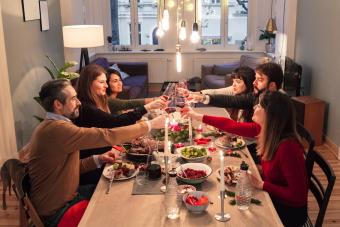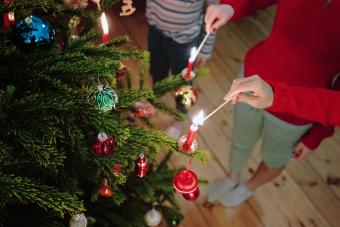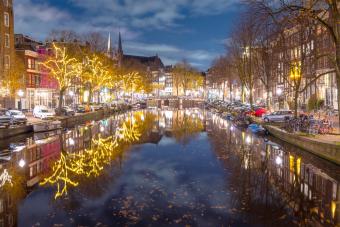
Some of your favorite things about Christmas, including a beautifully decorated tree, gifts, and a big delicious meal, can be traced back to German traditions. Learn more about these traditions, the intriguing history of the Christmas tree, why children get a shoe filled with gifts, and wonderful recipes for festive German Christmas food.
German Christmas Season
The Christmas season in Germany is a quiet, reflective time. It was once a strict religious observance, however, today it is not as somber as it once was. You will hear celebrants wish each other "Fröhlich Weihnachten" or "Merry Christmas." You will also hear "Frohe Festtage," meaning "Happy Holidays."
Advent season, or Advents Zeit, marks the beginning of the month-long holiday festivities. German Lutherans first used the Advent calendar in the 1800's. Children anticipate the arrival of Christmas by opening a new window on the calendar each day, revealing a treat such as a picture, poem, small gift, or chocolate. For the dinner table, families also decorate an Advent holly wreath and insert four red candles into it.
In addition, children write letters to the Christ Child, or the Christkindl, and either leave them on a windowsill or mail them to Himmel Stadt, where he was believed to live. Beginning on four Sundays prior to Christmas, children also light a candle, eat treats and sing holiday songs. They continue this practice each Sunday before the holiday and do it again on Christmas Day.
German Christmas Market
The outdoor Christmas market, or Weihnachtsmarkt, first started in Germany. People enjoy wandering the markets while drinking mulled wine to help stay warm. The vendor displays are colorful and tempting with items such as food, Christmas figurines and ornaments, Christmas decorations, and gifts such as toys, candy, jewelry and art.

German Christmas Decor
The Nutcracker is one famous decoration that originated in Germany. A folktale relays that a puppet-maker created a doll with a mouth and lever to crack nuts. He went on to win a nut cracking contest with this doll. The current wooden soldier design dates back to 19th century Germany and became popular in the U.S. after the first production of the ballet The Nutcracker.
Christmas Spirit Everywhere
The Germans also decorate their landscape, resulting in a beautiful and colorful scene. Homes and businesses are adorned with candles, evergreen boughs, and window dressings. Also, bakeries are well-stocked with holiday cookies and marzipan sweets, which are made of ground almonds, egg whites and sugar and colored and molded into decorative shapes.
Notable Days in the German Christmas Season
Christmastime in Germany consists of three days of significance in addition to Christmas Eve and Christmas Day. Each day is observed with specific activities.
St. Nicholas Day
Also known as Nikolaus tag, Saint Nicholas Day occurs on December 6th. It honors the third-century saint who inspired the modern-day Santa Claus. St. Nicholas devoted his entire life to serving the suffering and is known for selling his possessions and giving the money to the poor. Families would leave their shoes by the fire so they could dry from being out in the snow. This then grew into the tradition of putting out stockings and shoes on the night of December 5th. Subsequently, if the children have been good, St. Nicholas leaves gifts in their shoes or stockings. If they've been bad, he leaves them a twig or chunk of coal.
Christmas Eve
On December 24th, or Christmas Eve, families reveal their Christmas trees and exchange gifts. In northern Germany, the Christmas Man, or Weihnachstmann, is much like Santa Claus and is believed to leave gifts for children. In southern Germany, the Christkindl is the gift-bearer.
Historically on this day, Germans used to fast for religious observance. Now, Christmas Eve dinner is usually very simple, as not to distract from the tree and gifts. The meal typically includes potato salad and sausages. Or, carp might be served for dinner instead, a tradition that arose from the original fast that was done to honor Christmas Eve.
After celebrating the tree, exchanging gifts and eating dinner, many celebrants attend a midnight mass service.

Christmas Day
December 25th is typically a quiet day in Germany, spent with family having a big, scrumptious feast. The feast is known as Dickbauch which appropriately means "fat stomach." More on what Germans dine on for Christmas dinner is below.
St. Stephen's Day
St. Stephen's Day falls on December 26th. Known as the Second Christmas Day, or Zweite Weihnachtstag, this is an additional public holiday in Germany. It is traditionally spent serving those in need. It's also a day of enjoying the company of friends and family.
The Feast of Epiphany
This day falls on January 6th and is also called Heilige Drei Könige, which means Three Wise Men. The three kings who visited the Christ child were Caspar, Melchior, and Balthasar.
A distinct Catholic tradition in Germany is for children to write the initials of the three kings in chalk in front of the house on the night of January 5th, in order to protect the home and family. Catholic homes also often have a blessing written at the top of their front door; this writing is not removed until the following Christmas. Dressed as the three kings, children also sing carols and collect money for charity.
The Beloved Christmas Tree
For centuries, Germans have decorated evergreens around the time of the winter solstice. These trees hold a special significance because they stay green even through the cold, dark winter. Therefore, Germans appropriately called them "trees of life."
History of the Christmas Tree
In 17th century Germany, more people started to decorate evergreens in honor of Christ's birth and they eventually became known as Christmas trees. The practice spread throughout the country when Johann Wolfgang von Goethe featured a Christmas tree in his book The Suffering of Young Werther. As Germans emigrated to other lands, they spread the custom of the Christmas tree. A picture of a tree first appeared in an American newspaper in the mid-1800s.

Honoring the Christmas Tree
Prior to the modern Christmas lights you use today, the trees used to be decorated with candles, which is still done by some traditionalists. The Germans also decorated Christmas trees with fruit and nuts.
It is customary to reveal the decorated tree on Christmas Eve. Until then, it is hidden, even if that means that the tree has to be kept in a locked room. Then after dark on Christmas Eve, someone rings a bell and everyone rushes to see the tree in all its splendor. The tree is kept up until January 6th.
Another popular German Christmas tradition that is fun for adults is known as Christbaumloben. On St. Stephen's Day, December 26th, friends visit each other and declare upon arrival, "Ein schoener Baum!" meaning "A nice tree!" The family rewards them for this adulation with a bit of alcohol. They visit with the family for a while before moving on to the next house to make the same adulation and receive more treats.
O Tannenbaum
The lyrics of the famous German song "O Tannenbaum" date back to the 16th century. The title translates to "O Christmas Tree;" and the beautiful song is an homage to the Christmas tree, expressing how much joy it provides in the winter, because it is evergreen. The lyrics also state that the resilience and permanence of the tree provide hope and comfort any time of the year.

The German Christmas Feast & Goodies
No Christmas holiday would be complete without the special tastes of the season. The German Christmas feast traditionally consists of roasted goose, sauerkraut with apples and potato dumplings, all accompanied by Glühwein, mulled (sweet) wine. Another drink is Kinderpunsch, a non-alcoholic beverage made with tea, apple juice and honey.
The feast is rounded out with a variety of sweets. Lebkuchen are spicy cookies similar to gingerbread. Christstollen are long loaves of bread stuffed with citrus, dried fruit, and nuts. Stollen is a moist, fruit-filled dense bread. And last but certainly not least, there is Marzipankartoffeln, a dessert made of marzipan, a common German staple.
People often bake many small biscuits and cookies at home with the common ingredients of nuts and a lot of butter, and they are given as little pre-Christmas gifts to friends and family. Plätzchen is the name for a colorful dish of biscuits and cookies.
Enrich Your Christmas
Christmas is a meaningful, poignant and auspicious time. You can honor some of the origins by integrating German traditions into your holiday while also celebrating your own family traditions.







